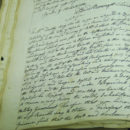Students associate 1776 with the American Revolution. But that’s only part of the story, according to author Ray Raphael.
Raphael’s book “The Spirit of ’74: How the American Revolution Began” focuses on sixteen months between the Boston Tea Party and Lexington and Concord. He says in this new narrative, Worcester native Timothy Bigelow was important.
Click the audio player above to hear Raphael’s conversation with New England Public Radio’s Carrie Healy.


9(MDA3MTA1NDEyMDEyOTkyNTU3NzQ2ZGYwZg004))
9(MDA3MTA1NDEyMDEyOTkyNTU3NzQ2ZGYwZg004))
9(MDA3MTA1NDEyMDEyOTkyNTU3NzQ2ZGYwZg004))
9(MDA3MTA1NDEyMDEyOTkyNTU3NzQ2ZGYwZg004))